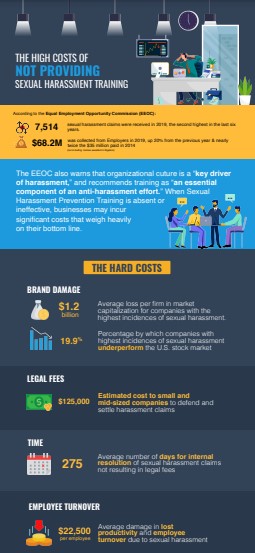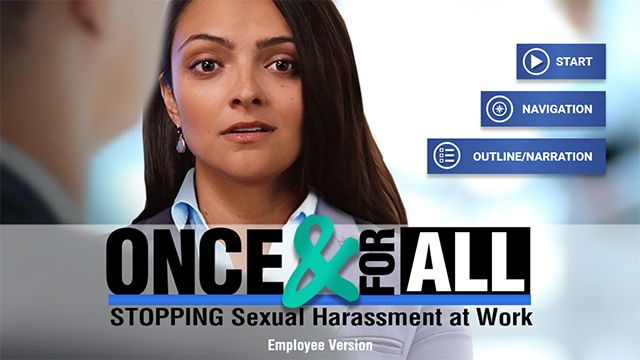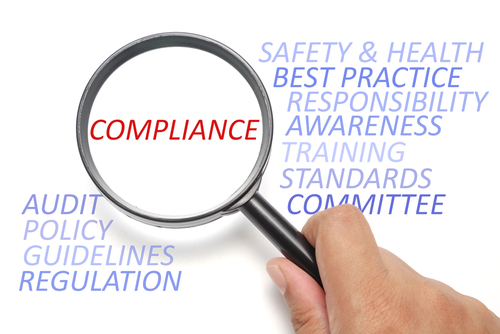What is Compliance Training?
Compliance describes the act of adhering to or complying with laws, regulations, rules, policies and standards. In the world of business, compliance ensures that organizations and their workforces understand and obey both internal and external regulations and policies governing the operations of the enterprise. Many organizations include ethics in their compliance programming.
- Corporate compliance refers to the process by which organizations ensure that employees adhere to a company’s own internal rules, standards, policies, and procedures that govern its operations.
- Regulatory compliance confirms that employees comply with applicable laws and regulations that originate outside the organization – such as those prescribed by local, state, and federal governments. Some industries also have certification, accreditation, or other oversight entities that stipulate policies and regulations governing organizational practices.
Ensuring that organizations and workforces comply with the full array of applicable rules and regulations can be an expensive undertaking, making some leaders hesitant to prioritize corporate and regulatory compliance. For instance, researchers estimate that large organizations spend an average of about $10,000 per employee just to ensure federal regulatory compliance. Nonetheless, experts confirm that costs arising from non-compliance pose significantly higher risks for organizations.
Compliance Training and Why It's Important
Companies deliver compliance training to employees to educate them on the various laws, regulations, policies and standards that apply to their jobs, organization, and industry. Compliance training may also teach individuals about the ethical issues they could encounter in their work and how to handle them. For the most part, compliance training is mandatory—for organizations to provide and for employees to attend.
At the individual level, effective compliance training equips employees with the knowledge they need to understand their responsibilities and provides guidance to inform decision-making and job performance. Consequently, workers require less supervision and are able to execute their duties more confidently and productively. Further, trained employees are better able to spot and report potential problems, enabling organizations to address issues before they result in non-compliance and/or legal action.
For their part, employers who provide compliance training and embed its principles into organizational culture are less likely to find themselves in violation of legal or ethical practices. Because regulatory violations can result in extensive fines, disruption to business operations, and damage employer brands and profitability, effective training helps ensure that employees adhere to all applicable laws and policies, thus reducing risks and contributing to strong and effective organizational performance.
For many companies—and especially those that operate in heavily regulated industries, such as healthcare or financial services—the cost of compliance can cause leaders to think twice about delaying, if not outright avoiding the investments required (even though most compliance training is mandatory). Data sources put the average cost of compliance for organizations across all industries at $5.47 million annually, and for firms in financial services at more than five times that figure.
However, the compliance and ethics information source Corporate Compliance Insights warns, “When an organization fails to meet compliance standards and regulations, increased costs come in the form of issues such as business disruption, productivity losses, revenue losses and fines, penalties and settlement costs.”
Recent statistics further underscore the prices organizations pay when they neglect compliance training, regular compliance audits, and other actions that ensure adherence to lawful operations and behaviors:
- On average, businesses lose more than $4 million in annual revenues because of non-compliance.
- Over the past decade (between 2011 and 2020), the cost for organizations responding to non-compliance incidents nearly doubled.
- Companies lose more than $5 million per year to business disruptions caused by non-compliance.
Compared to the potentially high prices organizations can pay for non-compliance, training that effectively educates employees about compliance issues is extremely cost-effective and a proven strategy for organizational risk protection. However, data on compliance training paints a concerning picture:
- Nearly one in four organizations (23%) offer no formal compliance training.
- Four in 10 organizations describe the compliance training they offer as reactive or basic.
- Only 12% of organizations offer advanced training in ethics and compliance.
- About 30% of companies that offer compliance training don’t measure program effectiveness.
High Costs of NOT Providing Sexual Harassment Training
At present, Sexual Harassment Prevention Training is mandated in some, but not all, states. It is a prime example of an area where a lack of training can prove extremely costly. See our full infographic


An enormous range of subjects fall under the umbrella of compliance. Topic requirements and necessary training can vary across industries, organizations, locations of operation, and even among business units and departments within organizations (for example, training for employees in a company finance department differs significantly from that required by workers in manufacturing units).
Some of the topics most often addressed in compliance include, but are not limited to, these:
- State and federal laws
- Workplace safety and OSHA regulations
- Workplace discrimination and EEOC regulations
- Diversity and inclusion
- Sexual harassment
- Workplace violence
- Workplace substance abuse
- Fraud prevention and detection
- Data privacy and security
- Business ethics
- Company and industry codes of conduct
- Company policies and procedures
Compliance Training Success
To ensure optimal outcomes, experts recommend the following for compliance training:
- Engaging formats that utilize video, and incorporate exercises and quizzes.
- Compelling scenarios that depict real-world situations to aid employee understanding.
- Leveraging third-party tools to keep training updated.
- Tracking and applying compliance training results to support stronger business operations.
Source: Corporate Compliance Insights
To ensure optimal outcomes, compliance training should be compulsory for all employees (if not mandated by external entities). Further, because laws and regulations undergo frequent changes, compliance training must be an ongoing organizational commitment. A typical delivery cadence begins with initial compliance training during new-employee orientation/onboarding and annual training updates for all company employees.
Media Partners’ award-winning training programs enable organizations to meet their legal obligations to deliver compliance training on a variety of critical topics. In addition, the company monitors fast-changing laws and training requirements for key compliance topics and provides timely guidance for customers.
The following links offer examples of some of Media Partners’ acclaimed compliance training solutions:

How Was Your Day?: Getting Real about Bias, Inclusion, Harassment, and Bullying: This 9-time award-winning respectful workplace training has helped thousands of organizations effectively address diversity, equity, inclusion, harassment and more.

Unintentional Still Hurts: Overcoming Unconscious Bias: This powerful new implicit bias training goes beyond the basics, focusing on impact vs. intent, the concept of microaggressions, and practical ways to identify, challenge, and respond to bias.

Once & For All: Stopping Sexual Harassment at Work: Worry-free sexual harassment prevention training is here with Once & For All. Just revised for 2022, It is the most effective training for inspiring immediate behavior change and building a culture of respect...and is the only program with a compliance guarantee.

Getting Real about Workplace Violence: Workplace Violence Awareness, Prevention, and Response Training: This highly-effective workplace violence prevention training helps people take action when needed, whether it be early, preventative action or decisive, life-saving action in response to an extreme violence event.


